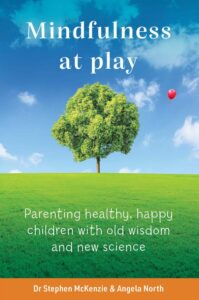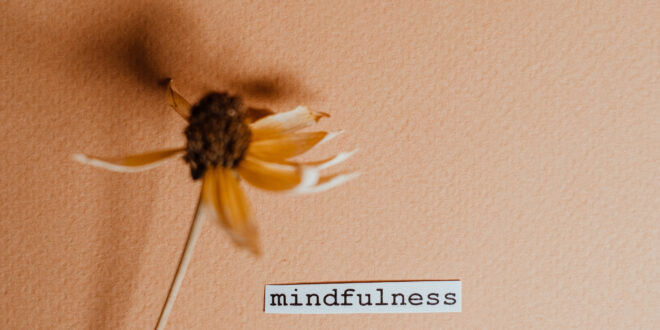 Extracted from Mindfulness at Play: Parenting healthy, happy children with old wisdom and new science by Dr Stephen McKenzie & Angela North, published by Exisle Publishing, RRP: $34.99
Extracted from Mindfulness at Play: Parenting healthy, happy children with old wisdom and new science by Dr Stephen McKenzie & Angela North, published by Exisle Publishing, RRP: $34.99
Mindfulness can be described as a technique that is thousands of years old which has become an overnight sensation. The modern success of this ancient wellness practice is particularly apt given that it connects our minds with our bodily sensations, which naturally grounds us in our here and now reality. When we mindfully accept life’s gift of the present moment, we are truly free; free of the stress that can overwhelm us when we continually want more from life than what we’re currently experiencing.
Mindfulness can help parents and their children be their best, as well as do their best. When we are mindful, we stop being too busy thinking about life to really enjoy it, and we can start living naturally and well. Mindfulness is a state of simply being fully focused on whatever we are doing, including parenting, right now. It allows us to reveal and be who we really are, and to help other people, including our children, reveal who they really are.
What mindfulness really is
A lot has been written and discussed about mindfulness; how-ever, it all just boils down to the practices of paying attention, being able to direct our attention, and accepting what we pay attention to. By removing our everyday distractions, mindfulness makes us fully alive. Mindfulness is actually a way into reality rather than out of it — a way of seeing things as they really are, no matter what they are.
The theory of mindfulness
Mindfulness produces benefits that can be measured scientifically. However, as with anything that has become as popular as the practice of mindfulness, there is a potential danger of some people either taking their belief too far, in that they don’t require scientific evidence of any kind or, on the other end of the spectrum, disliking it so much they disregard all and any scientific evidence that it works.
We need to keep an open mind and heart about what mindfulness can do for us and our children. We therefore describe benefits of mindfulness and mindfulness practices that are supported by scientific evidence. We balance this scientific support with constant reminders of the human essence of mindfulness. An example of this is reconnecting mindfulness with the humanistic wisdom traditions, including Buddhism, which is where the concept originally emerged from. We also balance theory with practice by including descriptions of why mindfulness works and how it works, demonstrated by real-life examples.
Scientifically supported benefits of mindfulness include vital elements related to life management such as:
- better parenting
- facilitation of healthy lifestyle change
- better sleep
- pain management
- coping with major illnesses, such as cancer
- reduced allostatic load (long-term stress response).
as well as elements that are related to mental health, including:
- depression-relapse prevention
- reduced anxiety, panic disorder and stress
- management of addiction
- better emotional regulation
- greater emotional intelligence.
Mindfulness can prevent people of all ages from developing mental, social or physical health problems. It can also help restore people to health if they have developed any of these problems by freeing them of their thoughts, including ones that can make them feel nervous or miserable, such as ‘I should do this!’, ‘I should do that!’, ‘people expect me to do it!’ or ‘I have to do it soon!’. Mindfulness therefore empowers people and reduces dependence on long-term psychotherapy or drug therapy. It also has the important advantage of being non-harmful, non-invasive, non-threatening and non-stigma producing.
The medical and psychiatric model for helping younger people generally makes an often artificial distinction between being ‘well’ and ‘unwell’. This is done on the basis of whether a young person has a diagnosed psychopathology or developmental disorder — such as social anxiety or dyslexia — which might be classified as being ‘unwell’, or whether they don’t — which would be classified as being ‘well’. Apart from being simplistic and often untrue, or at least less than fully true, this model can have unfortunate real-life consequences. Diagnosing a young person or anyone else with an official mental or physical condition can result in their not being offered opportunities to maximize their life. This is because official diagnoses can limit the perceptions of what a young person’s real-life opportunities could involve.
The practice of mindfulness
The proof of the mindfulness pudding is the experience of mindfulness itself. All applications of mindfulness, including for parenting, are best built on our own practice of it. To understand and practise mindfulness well enough to use it to help other people, including our children, we need to understand and practise it well enough to help ourselves. This is equivalent to the instruction in pre-flight safety demonstrations for us to help ourselves to the oxygen if it’s needed before helping our children to it.
It’s important that we don’t just move from being mindfulness pagans, who don’t know about it, to being mindfulness pagans who know about it but don’t practise it! We need to move from being mindfulness knowers to mindfulness livers, and this means knowing what mindfulness actually is and what its benefits really are, rather than just thinking we know what it means or what other people think it means.
To fully understand mindfulness, not only do we need to understand mindfulness practices, but we need to do them. A mindfulness practice can either be formal, which means participating in sessions such as mindful breathing or a body scan exercise, or informal, which means being mindful of — and connected to — whatever happens in our daily lives. Our informal practice of mindfulness is supported by our formal practice, and is simply:
being fully aware of whatever is taking place in this moment directing our awareness to whatever is real, rather than having it distracted by what imagined realities of what might be, or was, or otherwise isn’t accepting whatever is real.
Informal mindfulness practices
Informal mindfulness in daily living practices include:
- Mindful listening — really listen to the sound of the voice of anyone who is talking to you, rather than listening to your own internal voice. Be aware of your assumptions and judgements about whoever is talking to you, as well as your expectations about what they are going to say.
- Mindful communication — work towards achieving the best outcome with whoever you are communicating with, by practising active listening, and asking questions, rather than by trying to persuade them to agree with your solution. This is an ancient and effective communication practice that is known as the dialectic, or the Platonic/Socratic dialogue.
- Mindful walking — really connect with all or any sense while you are moving — the feel of your feet touching the ground, the aroma in the air or the noise around you.
- Mindful eating — concentrate on just the taste or texture of the food you are eating by removing any distractions around you while you eat such as watching TV, reading or moving around. Try an experiment: eat or drink anything you like with total awareness and then try eating or drinking the same thing while you are doing something else. Which experimental condition made the food taste better?
The key to unlocking any mindfulness practice and its life benefits is persistence — if you keep being still, you will stay still, naturally.
Formal mindfulness practices
This is a basic mindfulness technique which is best done for just a few minutes, at least, once a day, to gain the most benefit.
- Be still.
- Be aware of your natural breath — don’t try to change it, don’t judge it.
- Just let it flow.
- Be aware of your in-breath (inhalation), and your out-breath (exhalation), and the space between your in-breath and out-breath.
- Every time that you are aware that you are thinking about anything, gently bring your awareness back to focusing on your breath.









Join the Discussion
Type out your comment here:
You must be logged in to post a comment.